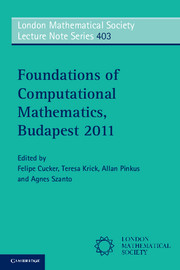Book contents
- Frontmatter
- Contents
- Preface
- Contributors
- 1 The State of the Art in Smale's 7th Problem
- 2 The Shape of Data
- 3 Upwinding in Finite Element Systems of Differential Forms
- 4 On the Complexity of Computing Quadrature Formulas for SDEs
- 5 The Quantum Walk of F. Riesz
- 6 Modulated Fourier Expansions for Continuous and Discrete Oscillatory Systems
- 7 The Dual Role of Convection in 3D Navier-Stokes Equations
- 8 Algebraic and Differential Invariants
- 9 Through the Kaleidoscope: Symmetries, Groups and Chebyshev-Approximations from a Computational Point of View
- 10 Sage: Creating a Viable Free Open Source Alternative to Magma, Maple, Mathematica, and MATLAB
- References
7 - The Dual Role of Convection in 3D Navier-Stokes Equations
Published online by Cambridge University Press: 05 December 2012
- Frontmatter
- Contents
- Preface
- Contributors
- 1 The State of the Art in Smale's 7th Problem
- 2 The Shape of Data
- 3 Upwinding in Finite Element Systems of Differential Forms
- 4 On the Complexity of Computing Quadrature Formulas for SDEs
- 5 The Quantum Walk of F. Riesz
- 6 Modulated Fourier Expansions for Continuous and Discrete Oscillatory Systems
- 7 The Dual Role of Convection in 3D Navier-Stokes Equations
- 8 Algebraic and Differential Invariants
- 9 Through the Kaleidoscope: Symmetries, Groups and Chebyshev-Approximations from a Computational Point of View
- 10 Sage: Creating a Viable Free Open Source Alternative to Magma, Maple, Mathematica, and MATLAB
- References
Summary
Abstract
We investigate the dual role of convection on the large time behavior of the 3D incompressible Navier-Stokes equations. On the one hand, convection is responsible for generating small scales dynamically. On the other hand, convection may play a stabilizing role in potentially depleting nonlinear vortex stretching for certain flow geometry. Our study is centered around a 3D model that was recently proposed by Hou and Lei in [23] for axisymmetric 3D incompressible Navier-Stokes equations with swirl. This model is derived by neglecting the convection term from the reformulated Navier-Stokes equations and shares many properties with the 3D incompressible Navier-Stokes equations. In this paper, we review some of the recent progress in studying the singularity formation of this 3D model and how convection may destroy the mechanism that leads to singularity formation in the 3D model.
Introduction
Whether the 3D incompressible Navier-Stokes equations can develop a finite time singularity from smooth initial data with finite energy is one of the seven Millennium problems posted by the Clay Mathematical Institute [16]. This problem is challenging because the vortex stretching nonlinearity is super-critical for the 3D Navier-Stokes equation. Conventional functional analysis based on energy type estimates fails to provide a definite answer to this problem. Global regularity results are obtained only under certain smallness assumptions on the initial data or the solution itself. Due to the incompressibility condition, the convection term seems to be neutrally stable if one tries to estimate the Lp (1 < p≤∞) norm of the vorticity field. As a result, the main effort has been to use the diffusion term to control the nonlinear vortex stretching term by diffusion without making use of the convection term explicitly.
- Type
- Chapter
- Information
- Foundations of Computational Mathematics, Budapest 2011 , pp. 129 - 164Publisher: Cambridge University PressPrint publication year: 2012

